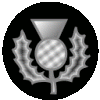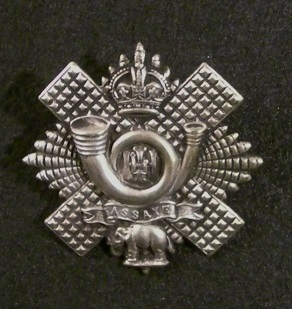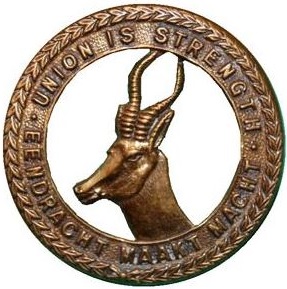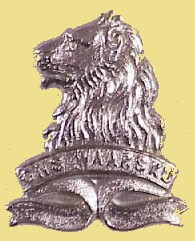
The 9th (Scottish) Division, was an infantry division of the British Army during the First World War, one of the Kitchener's Army divisions raised from volunteers by Lord Kitchener to serve on the Western Front during the First World War.

The South African Army is the principal land warfare force of South Africa, a part of the South African National Defence Force (SANDF), along with the South African Air Force, South African Navy and South African Military Health Service. The Army is commanded by the Chief of the Army, who is subordinate to the Chief of the SANDF.

The Lancashire Fusiliers was a line infantry regiment of the British Army that saw distinguished service through many years and wars, including the Second Boer War, the First and Second World Wars, and had many different titles throughout its 280 years of existence. In 1968 the regiment was amalgamated with the other regiments of the Fusilier Brigade – the Royal Northumberland Fusiliers, Royal Warwickshire Fusiliers and the Royal Fusiliers – to form the current Royal Regiment of Fusiliers.

The Argyll and Sutherland Highlanders (Princess Louise's) is a light infantry company (designated as Balaklava Company, 5th Battalion, Royal Regiment of Scotland) and was a line infantry regiment of the British Army that existed from 1881 until amalgamation into the Royal Regiment of Scotland on 28 March 2006.

The Battle of Delville Wood(15 July – 3 September 1916) was a series of engagements in the 1916 Battle of the Somme in the First World War, between the armies of the German Empire and the British Empire. Delville Wood (Bois d'Elville), was a thick tangle of trees, chiefly beech and hornbeam, with dense hazel thickets, intersected by grassy rides, to the east of Longueval. As part of a general offensive starting on 14 July, which became known as the Battle of Bazentin Ridge (14–17 July), General Douglas Haig, Commander of the British Expeditionary Force, intended to capture the German second position between Delville Wood and Bazentin le Petit.

The Solomon Mahlangu Regiment is a reserve infantry regiment of the South African Army.

The Cape Town Highlanders is a reserve mechanised infantry regiment of the South African Army.

The Bambatha Rifles is a reserve mechanised infantry regiment of the South African Army.

The Highland Light Infantry (HLI) was a light infantry regiment of the British Army formed in 1881. It took part in the First and Second World Wars, until it was amalgamated with the Royal Scots Fusiliers in 1959 to form the Royal Highland Fusiliers which later merged with the Royal Scots Borderers, the Black Watch, the Highlanders and the Argyll and Sutherland Highlanders to form the Royal Regiment of Scotland, becoming the 2nd Battalion of the new regiment.

The Gordon Highlanders was a line infantry regiment of the British Army that existed for 113 years, from 1881 until 1994, when it was amalgamated with The Queen's Own Highlanders to form The Highlanders. Although the 'Gordon Highlanders' had existed as the 92nd Regiment of Foot since 1794, the actual 'Gordon Highlanders Regiment' was formed in 1881 by amalgamation of the 75th (Stirlingshire) Regiment of Foot and 92nd Regiment of Foot.

Andrew Mlangeni Regiment is a reserve infantry regiment of the South African Army.

The Chief Langalibalele Rifles is a reserve infantry regiment of the South African Army.

The Seaforth Highlanders was a line infantry regiment of the British Army, mainly associated with large areas of the northern Highlands of Scotland. The regiment existed from 1881 to 1961, and saw service in World War I and World War II, along with many smaller conflicts. In 1961 the regiment was amalgamated with the Queen's Own Cameron Highlanders to form the Queen's Own Highlanders, which merged, in 1994, with the Gordon Highlanders to form the Highlanders. This later joined the Royal Scots Borderers, the Black Watch, the Royal Highland Fusiliers and the Argyll and Sutherland Highlanders to create the present Royal Regiment of Scotland.

The Queen's Own Cameron Highlanders or 79th Regiment of Foot was a line infantry regiment of the British Army, raised in 1793. It amalgamated with the Seaforth Highlanders to form the Queen's Own Highlanders in 1961.

The Glasgow Highlanders was a former infantry regiment of the British Army, part of the Territorial Force, later renamed the Territorial Army. The regiment eventually became a Volunteer Battalion of the Highland Light Infantry in 1881. The regiment saw active service in both World War I and World War II. In 1959 the Highland Light Infantry was amalgamated with the Royal Scots Fusiliers to form the Royal Highland Fusiliers. The Glasgow Highlanders was later amalgamated into the 52nd Lowland Volunteers in 1967.

The South African Overseas Expeditionary Force (SAOEF) was a volunteer military organisation in World War I.

The South African 1st Infantry Brigade was an infantry brigade of the army of the Union of South Africa during World Wars I and II. During World War I, the brigade served as a British formation in Egypt and on the Western Front, most famously the Battle of Delville Wood. It was reactivated at the start of the Second World War as a South African formation and served in East Africa and the Western Desert; the brigade disbanded on 1 January 1943.

The General de la Rey Regiment is an reserve infantry regiment of the South African Army.

1st SA Infantry Regiment was an infantry regiment of the South African Army, during World War I.



















